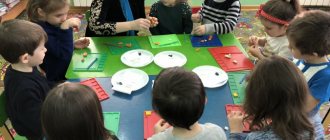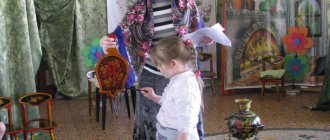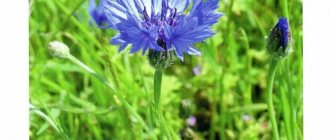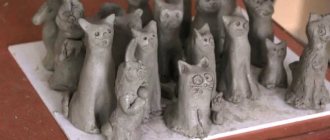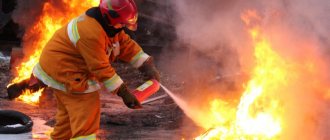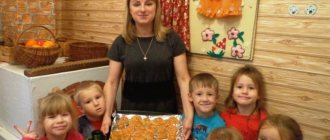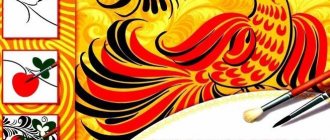NOD “Sculpting a cat” in the preparatory group
Anna Orpanen
NOD “Sculpting a cat” in the preparatory group
Direct educational activities.
Topic: sculpting a cat
Objectives: educational - strengthening the skill of sculpting in parts , from a whole piece. Improve the ability to freely use different sculpting (pulling, attaching, fastening parts, strengthen the ability to convey the proportions of the animal’s body.
Developmental: develop aesthetic feelings, the ability to work carefully.
Educational: to cultivate interest in knowledge of nature, independence, interest in modeling , the desire to complete the work started.
Equipment: plasticine, stacks, oilcloths, illustrations of cats, toys (cats and cats)
.
Preliminary work: examination of illustrations, photo illustrations about cats and cats, children's stories about their cats and their habits, drawings “My favorite pet”
, presentation
"Cats"
.
Summary of educational activities for sculpting “Kitten” in the senior mixed-age group
Yulia Terentyeva
Summary of the educational activity for sculpting “Kitten” in the senior mixed-age group
Abstract of GCD on artistic and aesthetic development: modeling .
Theme: " Kitten "
Senior mixed age group
Goal: to create conditions for developing the ability to sculpt a cat from a whole piece of plasticine, conveying the proportions of the animal.
1. To strengthen children’s ability to sculpt the figure of an animal in parts, using various techniques: rolling plasticine between the palms, pulling small parts, connecting parts by pressing and smoothing the joints.
2. Develop fine motor skills and logical thinking; speech and motor activity, memory, activate vocabulary.
3. Cultivate compassion for animals and a desire to help them; cultivate emotional responsiveness.
Modeling techniques on this topic
Modeling in the preparatory group reaches a qualitatively new level:
- Preschoolers already have more developed fine motor skills.
- Observing the objects of the surrounding reality, they notice their characteristic features, and are able to more or less accurately convey them through visual activity.
- The children are better oriented in space, and therefore understand how to arrange the elements of the craft relative to each other.
- Children develop a desire and ability to more accurately convey the proportions of objects; they are fascinated by the process of creating details that complement the image.
In the preparatory group, a lot of attention is paid to the sculpting of a person, the most difficult object to depict. At the same time, it is proposed to depict it in dynamics, as well as in the context of the plot composition. So, in addition to the topic that interests us (“Child with a kitten”), preschoolers create images of dancing children, a girl playing ball (or other crafts at the discretion of the teacher).
In the preparatory group, a lot of attention is generally paid to sculpting a person in motion
Children already understand that to depict a step or other actions, you can not only position the legs and arms of the figures, but also bend them, due to which the images become more expressive.
The “Child with a Kitten” sculpture (it could be a puppy) involves a fairly large amount of work. After all, a preschooler must sculpt individual elements of the composition (a person and an animal), supplement them with the necessary small details, and then give them the desired position (convey dynamics) in order to obtain a complete composition.
The initial task of working on this topic is to sculpt a human (child) figure. The guys already know that this can be done in various ways:
- Sculptural (sculpting body parts from a single piece of plasticine using the pulling method).
When sculpting, body parts are formed from a single piece of plasticine
- Constructive (by sculpting each body part and clothing separately, and then connecting them to each other).
The cloning method involves sculpting each part of the body, elements of clothing, and then assembling the image
- Combined.
Modeling using a constructive method takes longer, but is easier for preschoolers. The difficulty of the sculptural method lies in the fact that you need to determine by eye the amount of material needed for a particular part of the body.
Examples of step-by-step sculpting of a person in the preparatory group can be found in the article “Sculpting “Man in Motion” in the preparatory group: composition options and a variety of working techniques.”
Similarly, the animal with which the child plays can be sculpted using sculptural and constructive methods.
An animal, like a person, can be depicted in sculpting in different ways.
You can also use a combined method: sculpt the body and legs from a single piece of plasticine, and work out the remaining parts separately.
From a single piece you can sculpt, for example, only the body and legs of an animal
Abstract of an OOD on modeling on the theme “Kitten” in the senior group of a preschool educational institution
Alina Selikhova
Abstract of an OOD on modeling on the theme “Kitten” in the senior group of a preschool educational institution
Abstract of OOD in the educational field Artistic and aesthetic development: modeling on the theme “ Kitten ”
in
the senior group of preschool educational institutions
Goal: to create conditions for developing the ability to sculpt a cat from a whole piece of plasticine, conveying the proportions of the animal.
— To consolidate the ability to sculpt the figure of an animal in parts, using various techniques: rolling plasticine between the palms, pulling small parts, connecting parts by pressing and smoothing the joints. Developmental tasks:
— Develop fine motor skills and logical thinking; — Develop speech and motor activity, memory, activate vocabulary;
— Continue to develop interest in sculpting .
— Cultivate compassion for animals and a desire to help them;
— Cultivate emotional responsiveness.
Integration of educational areas:
1. Cognitive development: generalization of ideas about domestic animals;
2. Speech development: development of speech activity, activation of the vocabulary;
3. Socio-communicative development: developing empathy for animals, the desire to help them.
Preliminary work with children: Reading the Russian folk tale “The Cat, the Rooster and the Fox”
, E. Charushin
“Cat”
, S. Marshak
“Mustachioed - Striped”
, G. Oster
“
Kitten named Woof ” , L. N. Tolstoy
“Lion and the Dog”
,
“
Kitten ” ;
reading nursery rhymes; solving riddles; conversations about kittens; looking at illustrations of kittens; didactic game "Pets"
;
monitoring kittens at home; outdoor games “Mice dance in a circle”
,
“Mousetrap”
.
Equipment and materials: Handout: plasticine, modeling , stack, napkins, additional material (cereals, pasta)
.Demonstration material: basket, soft toy kitten, presentation
“
Modeling a kitten ” ,
modeling diagram in A3 format , plasticine kitten - sample.
Musical accompaniment: audio recording of the play “The Cat Is Sick”
A. T. Grechaninova, phonogram from the cartoon
“Leopold the Cat”
.
Node progress
-What kind of animal is playing with me?
Children's stories about their pets (habits, favorite activities, etc.)
_What benefits do cats bring to a person’s life?
— Today we will sculpt a cat .
What parts do we need to sculpt to make a cat ?
(head - round, body - oval, ears - triangular, 4 legs - “sausages”
, tail –
“sausage”
)
Showing clearly the sequential execution of the product.
1 let's make the head. Take some plasticine and roll it into a ball.
2 make triangular ears and connect them to the ball.
3 let's mold the body. Let's make an oval, it must be larger than the head so that our cat is stable .
4 put the oval on the table and press it so that the oval has a flat base - our cat will sit .
Lesson summary on plasticineography “Child with a kitten”
Lyudmila Bolgova
Summary of the lesson on plasticineography “Child with a kitten”
Topic: Child with a kitten . Preparatory group.
a simple scene using , showing the movement of human and animal figures.
- fix to depict a human figure in motion.
— Strengthen the ability to sculpt an animal figurine in parts.
- consolidate the ability to use techniques: pinching, pulling, rolling, rolling, joining.
Materials: boards, napkins, plasticine , illustration “ Child with a kitten ”
, stack, colored cardboard.
with plasticine again . But first, let's listen to the poem.
Where he came from the cradle,
He began to take him in his arms,
The kitten needs to be fed,
The world of childhood is sensitive, subtle,
And so that the child becomes kind,
-Raise your hands which of you has a furry friend? Today you will use plasticine to draw how you play with your pet.
But first, let's stretch our fingers.
(we make a circle from the thumb and all other fingers of the left hand)
(“go” with the index and middle fingers of the right hand)
(with your index finger we make “lacking” movements in a circle representing a pot)
(put your finger deeper into the pot circle)
(trying to pull the finger out of the circle)
(stomping the fingers of both hands on the table, showing how the cat ran away)
Now let's get to work.
GCD summary in the first junior group “Observing a kitten” GCD summary in the first junior group. Observing a kitten. Objectives: 1. Introduce the appearance of a kitten: small, head, on the head.
GCD summary in the first junior group “Observing a kitten” GCD summary in the first junior group. Observing a kitten. Objectives: 1. Introduce the appearance of a kitten: small, head, on the head.
Notes for a lesson on plasticineography “Goldfish” Notes for plasticineography “Goldfish”. Senior group Goal: developing the ability to work with plasticine using the plasticineography technique. Tasks:.
